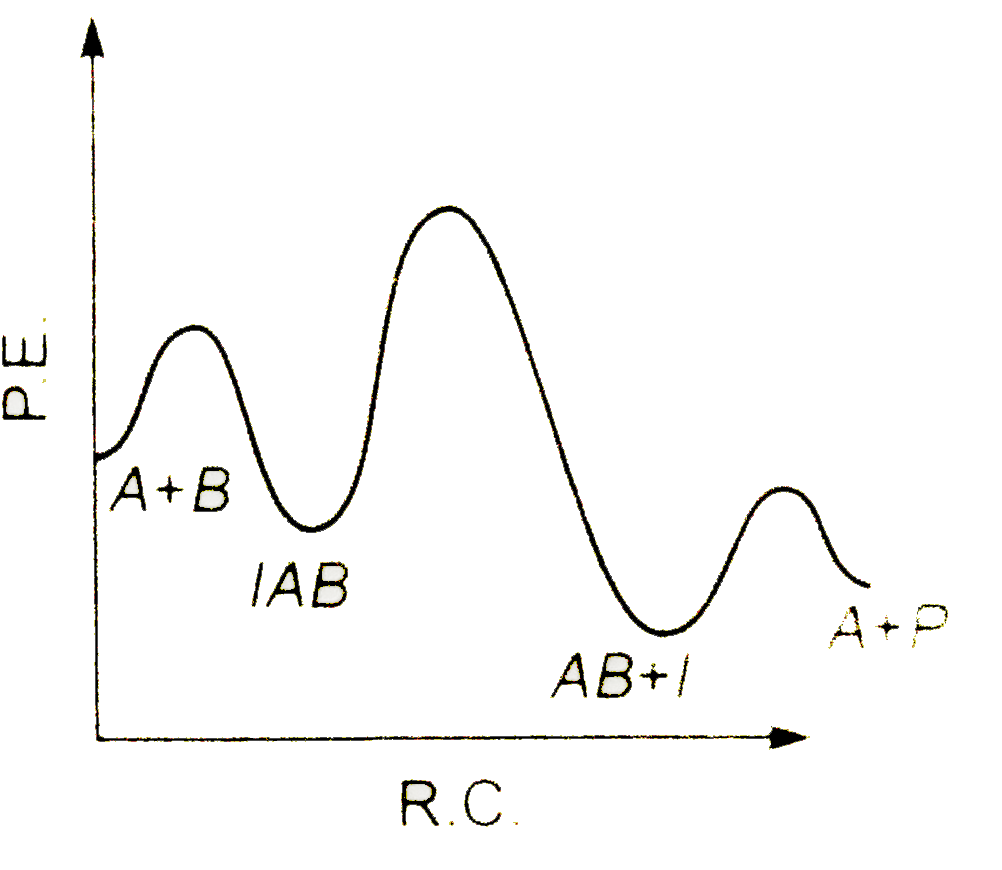The following mechanism has been proposed for the exothermic catalyzed cmplex reaction:
A+BFast−−→IABk1−−→AB+Ik2−−→P+A
If k1 is much smaller than k2, the most suitable qualitative plot of potential energy (PE) versus reaction coordinates for the above reaction is Solution in Telugu




The correct Answer is:B
Step by step video & image solution for The following mechanism has been proposed for the exothermic catalyzed cmplex reaction: A + B overset("Fast")rarr IABoverset(k_(1))rarrAB+Ioverset(k_(2))rarrP+A If k_(1) is much smaller than k_(2), the most suitable qualitative plot of potential energy (PE) versus reaction coordinates for the above reaction is by Chemistry experts to help you in doubts & scoring excellent marks in Class 12 exams.
Updated on:21/07/2023Topper's Solved these Questions
- CHEMICAL KINETIC & NUCLEAR CHEMISTRYBOOK - NARENDRA AWASTHICHAPTER - CHEMICAL KINETIC & NUCLEAR CHEMISTRYEXERCISE - Level 1 (Q.3 To Q.32)
2 Videos
- CHEMICAL KINETIC & NUCLEAR CHEMISTRYBOOK - NARENDRA AWASTHICHAPTER - CHEMICAL KINETIC & NUCLEAR CHEMISTRYEXERCISE - Level 1 (Q.33 To Q.62)
3 Videos
- SURFACE CHEMISTRYBOOK - NARENDRA AWASTHICHAPTER - SURFACE CHEMISTRYEXERCISE - Level 3 - Assertion - Reason Type Questions
1 Videos
Similar Questions
The reaction of A2 and B2 follows the equation
A2(g)+B2(g)→2AB(g)
The following data were observed
[A2]0[B2]0Initial rate of appearance of AB(g)(inMs−10.100.102.5×10−40.200.105×10−40.200.2010×10−4
The value of rate constatnt for the above reaction is :
View SolutionHalf-life (t1/2) and completion time (T) of the reaction (A→2B) are if initial concentration A is 1M and k = 0.001M/ min :
View Solutioneach question constain STATEMENT-1(Assertion ) and STATEMENT - 2 (reason). examine the statement carefully and work the correct answer accoridng to the instructions given below :
STATEMENT-1: Dispersed phase particles of colloidal solution cannot pass through ultra -filter paper.
STATEMENT-2: The size of colloidal particles are larger than the size of true solution particles.
View SolutionMechanism of the reaction is:
Ak1−−→B,2Ak2−−→C+D
What is −d[A]dt ?
View SolutionConisder the reaction mechanism: A_(2) overset(k_(eq))hArr 2A ("fast") (where A is the intermediate.) A+B underset(k_(1))rarr P (slow) The rate law for the reaction is
View SolutionThe following mechanism has been proposed for the exothermic catalyzed cmplex reaction:
A+BFast−−→IABk1−−→AB+Ik2−−→P+A
If k1 is much smaller than k2, the most suitable qualitative plot of potential energy (PE) versus reaction coordinates for the above reaction is
View SolutionThe mechanism of the reaction
2NO+O2→2NO2 is
NO+NOk1⇐⇒k−1N2O2(fast)
N2O2+O2k2−−→2NO2(slow)
The rate constant of the reaction is
View SolutionA consecutive reaction, A overset(K_(1))(rarr)B overset(K_(2))(rarr)C is characterised by:
View SolutionA hypothetical reaction : A_(2)+B_(2)rarr 2AB Follows mechanism as given below : A_(2) overset(k_(c))hArr A+A................( fast )" "(k_(C)- is equilibrium constant ) A+B_(2)overset(k_(1))rarrAB+B...............(" slow")" "(k_(1)- rate constant ) A+B underset(K_(2))overset(k_(2))hArrAB...............( fast )" "(k_(2),k_(3)- are rate constant ) Give the rate law.
View SolutionIn the sequence of reaction,
Lk1−−→Mk2−−→Nk3−−→O
k3>k2>k1
The rate determining step of the reaction is :
View SolutionIn the following first order reactions (A)overset(k_(1))rarr"product",(B)overset(k_(2))rarr"product" , the ratio k_(1)//k_(2) if 90% of (A) has been reacted in time 't' while 99% of (B) has been reacted in time 2t is :
View SolutionThe reaction mechanism for the reaction PtoR is as follows: Punderset(k_(2))overset(k_(1))hArr2Q("fast"),2Q+poverset(k_(3))toR("slow") the rate law for the net reaction (ptoR) is:
View SolutionIn the following first order competing reactions A overset(k_(1))rarr B, C overset(k_(2)) rarr D . If only 50% of A have been reacted whereas 94% of C has been reacted in the same time interval then find the ratio of (k_(2))/(k_(1)) .
View Solution2A rarr B+C The mechanism of the above reaction given as 2A overset(K_(1))underset(K_(2))hArrX+2B (fast) X+B overset(K_(3))rarrC (slow) E_(1) = Activation energy for K_(1) K_(2) = Activation energy for K_(2) E_(3) =Activation energy for K_(3) Calculate E_("reaction") (given : E_(1) =10 kJ, E_(3)=5 kJ, E_(2) =12 kJ)
View SolutionIn the sequence of reaction
AK1−−→BK2−−→CKc−−→D,K3>K2>K1 then the rate determining step of the reaction is
View SolutionMechanism of the reaction is: A overset(k_(1))rarrB, 2Aoverset(k_(2))rarr C + D What is (-d[A])/(dt) ?
View Solution
